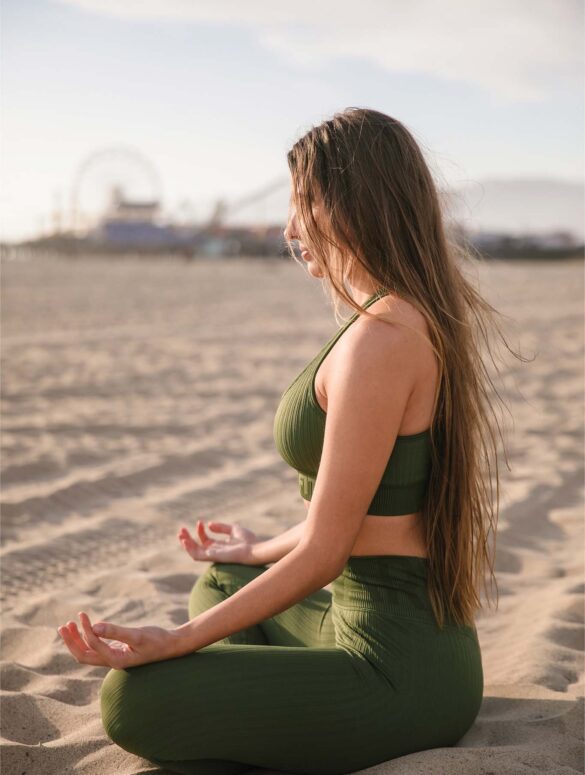Text by Lindsey Kesel
From its storied history of sport and fitness firsts to an enduring attitude of wellness, Santa Monica’s title as a health-conscious coastal haven is undisputed.
While 300-sunny days a year, epic beaches, and cleansing ocean air is motivation enough to live a healthy lifestyle, Santa Monica stands apart from other beach towns dotting the Southern California coast. There’s just something about the city’s 8.3 square miles that oozes vitality. Whether Santa Monica’s unshakeable health-savvy stamp is part of a well-crafted plan to design an enclave of wellness, or simply a side effect of its fit-focused heritage, all varieties of activity and mindfulness are welcome here.
Santa Monica resident and Waves contributor Anne Wallentine suggests her fair city emanates an openness to adventure that spills over from the metropolis to the east: “L.A. is a place that attracts a lot of people who are interested in exploring new frontiers, whether it’s health or arts or whatever they’re into.”
As a curator for the Santa Monica History Museum, she’s studied the city’s evolution over the last century. “Santa Monica used to be more of a sleepy beach town on the fringes of L.A.,” she says. “When the freeway was built in the 1960s, that was a turning point for the city—both for connecting it to broader Los Angeles and attracting more of an upscale tourist crowd.”
A true mecca of movement, Santa Monica offers easy access to the great outdoors, high walkability, and close proximity to ocean and mountain terrain. The 3.5-mile Santa Monica State Beach is a perpetual playground for everyone from surfers, kayakers, kitesurfers, runners, and volleyballers, to stillness-seekers practicing meditation and sound bath sessions on the sand.

Scenic overlooks and palm-studded paths turn public spaces like Palisades Park into enchanting exercise venues. Resources like the iconic Santa Monica Stairs—170 steps descending an overall vertical change of about 110 feet into Santa Monica Canyon—challenge everyday athletes and weekend warriors. The city’s robust bicycle infrastructure caters to peddlers with the Metro Bike Share program, the 22-mile Marvin Braude Bike Trail tracing the shoreline, and a 20-year Bike Action Plan aiming for 35% bicycle mode share by 2030.
While fitness is always on-trend in California, Santa Monica boasts a bevy of physique-building options: Brazilian jiu-jitsu and boxing academies; Pilates, Barre, HIIT, and cycling studios; and all-encompassing gyms and health clubs, to name a few. There’s also an eclectic assortment of day spas that perform holistic relaxation and recovery therapies, from the more traditional massages, facials, and body scrubs, to biohacking methods such as sensory deprivation tanks, infrared saunas, and cryotherapy.
In 2018, after noticing most of his clients were Santa Monica residents, personal trainer Julian Hess went from doing home visits to hosting workouts at The Study L.A., a “fitness sanctuary with 2,500 square feet of ultra clean, human-powered training space located in the heart of Santa Monica.”
With a wealth of ways to shape up, Hess helps clients find the right fit, then apply consistency and effort. “Do that mud bath or meditation, but understand that’s not going to help you do a push-up. Choose the thing you really love doing and get after it,” he adds.
Santa Monica’s affinity for wellness also extends to conscious cuisine, from organic farmer’s markets and farm-to-table restaurants, to scores of healthy fast-casual eateries. One popular stop in downtown, The Hive Superfood Eats & Organic Café, is known for its “sneaky healthy” juice blends, kombucha tea, immunity shots, and build-your-own bowls.

After Richard Peters and Constantine Savvides met on a 10-day Vipassana meditation retreat, they opened The Hive with the intention to build a community around true nourishment. With a mantra of “bee yourself,” The Hive caters to the spirit of individualism the city is known for with a flexible, modification-friendly menu.
“Santa Monica is probably one of the healthiest cities in the country as far as the general mindset of people,” says Peters. “People tend to have a holistic approach to eating better and living healthier, versus having to go to the doctor when you have a problem.”
Santa Monica’s high health IQ owes a sizeable debt of gratitude to earlier decades that championed innovations in sports and fitness. Even before the “Z-boys” of Zephyr Skate Team put the city’s Ocean Park neighborhood on the map with their surf-styled skateboarding, Santa Monica was launching the new water sport of paddleboarding and kicking off a fitness phenomenon on Muscle Beach.
Though stand-up paddleboarding (SUP) took root with legendary Waikīkī watermen in the 1950s, a simplified version is said to have originated in Santa Monica harbor in 1932 with surfer Tom Blake. Blake modified the heavy 14-foot-plus wooden surfboards the Hawaiians were riding, built a lighter, hollow board strictly for prone paddling with the arms, and shared them with the local lifeguards. As paddleboarding took off, two spinoff sports also originated in the harbor—paddleboard water polo and paddleboard water ballet.
Jim Harris, executive director for the Santa Monica Pier and author of the 2009 book The Santa Monica Pier: A Century on the Last Great Pleasure Pier shares the origin story of the country’s first public paddleboard club:
In 1940, Ed Hawkins entered his 9-year-old daughter, Dorothy “Dottie” Lee Hawkins, in a paddleboard race against adult athletes at Ballona Creek. When Dottie took third place, Ed knew he needed to nurture her talent, but there was the matter of cost. Balking at the high fees the private clubs were charging, Hawkins founded Hui Maiokioki (later renamed Manoa Paddleboard Club) on the west end of the Pier, with no entry fees and 25-cent monthly dues. Throughout her career, Dottie never took less than first place, and became the personal paddleboarding trainer for Olympic gold medalist swimmer and ‘Tarzan” actor Johnny Weissmuller.
In the 1930s, the exercise extravaganza Muscle Beach was branding Santa Monica as the birthplace of the fitness movement. Just south of the Pier, a motley crew of amateur athletes drew crowds with their dynamic displays of acrobatics, gymnastics, wrestling, human pyramids, and stunt performances. As word spread, famous actors, celebrities, and bodybuilders came through. Though Muscle Beach eventually relocated to Venice Beach, the Original Muscle Beach location continues to attract “families, fitness freaks, and tourists” with a setup of parallel bars, ropes and swings, and aerial silks.
Today, the Santa Monica Pier remains a lively launch pad for the city’s “something for everyone” appeal, playing host to myriad fit-focused events like the Arnold Strongman USA Championship, Wanderlust Festival, and Wellness and Waves’ free yoga by the sea. The granddaddy of them all, the annual Pier 360 Ocean Sports and Beach Festival in June, celebrates the city’s legacy of innovation and inclusivity with epic “paddle battles” and surf, skate, swim, and other competitions that are open to anyone up for a challenge. For visitors who prefer to just hang out, Santa Monica Trapeze School gives lessons right on the Pier to test one’s inner acrobat.
“Santa Monica just has a coolness about it,” says Hess, the trainer. “Being healthy is part of the culture here. Everyone wants to look good like a Hollywood movie star, and they’re out here getting fit.”


